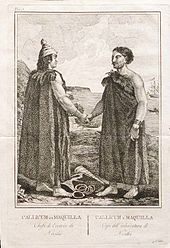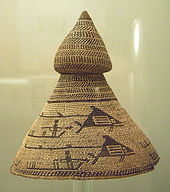
The Nuu-chah-nulth, also formerly referred to as the Nootka, Nutka, Aht, Nuuchahnulth or Tahkaht, are one of the Indigenous peoples of the Pacific Northwest Coast in Canada. The term Nuu-chah-nulth is used to describe fifteen related tribes whose traditional home is on the west coast of Vancouver Island.

John Meares was an English navigator, explorer, and maritime fur trader, best known for his role in the Nootka Crisis, which brought Britain and Spain to the brink of war.
The Nootka Sound Conventions were a series of three agreements between the Kingdom of Spain and the Kingdom of Great Britain, signed in the 1790s, which averted a war between the two countries over overlapping claims to portions of the Pacific Northwest coast of North America.

Nootka Sound is a sound of the Pacific Ocean on the rugged west coast of Vancouver Island, in the Pacific Northwest, historically known as King George's Sound. It separates Vancouver Island and Nootka Island, part of the Canadian province of British Columbia. It played a historically important role in the maritime fur trade.
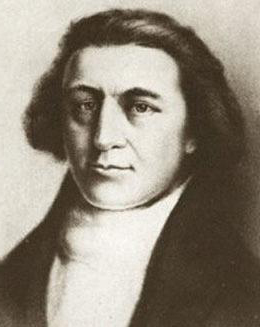
Robert Gray was an American Merchant Sea Captain who is known for his achievements in connection with two trading voyages to the northern Pacific coast of North America, between 1790 and 1793, which pioneered the American maritime fur trade in that region. In the course of those voyages, Gray explored portions of that coast and in the year 1790 he completed the first American circumnavigation of the world. He was also noted for coming upon and naming the Columbia River, in 1792, while on his second voyage.
Nuu-chah-nulth, a.k.a.Nootka, is a Wakashan language in the Pacific Northwest of North America on the west coast of Vancouver Island, from Barkley Sound to Quatsino Sound in British Columbia by the Nuu-chah-nulth peoples. Nuu-chah-nulth is a Southern Wakashan language related to Nitinaht and Makah.
John Kendrick (1740–1794) was an American sea captain during the American Revolutionary War, and was involved in the exploration and maritime fur trading of the Pacific Northwest alongside his subordinate Robert Gray. He was the leader of the first US expedition to the Pacific Northwest. He is known for his role in the 1789 Nootka Crisis, having been present at Nootka Sound when the Spanish naval officer José Esteban Martínez seized several British ships belonging to a commercial enterprise owned by a partnership of companies under John Meares and Richard Cadman Etches. This incident nearly led to war between Britain and Spain and became the subject of lengthy investigations and diplomatic inquiries.
The Mowachaht/Muchalaht First Nations are a First Nations government on the west coast of Vancouver Island in the Canadian province of British Columbia. The Mowachaht/Muchalaht First Nations are a member nation of the Nuu-chah-nulth Tribal Council, which spans all Nuu-chah-nulth-aht peoples except for the Pacheedaht First Nation.

Dionisio Alcalá Galiano was a Spanish naval officer, cartographer, and explorer. He mapped various coastlines in Europe and the Americas with unprecedented accuracy using new technology such as chronometers. He commanded an expedition that explored and mapped the Strait of Juan de Fuca and the Strait of Georgia, and made the first European circumnavigation of Vancouver Island. He reached the rank of brigadier and died during the Battle of Trafalgar.
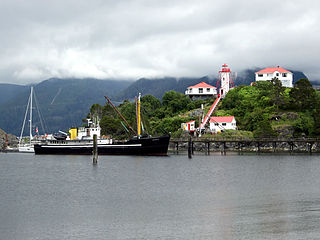
Yuquot, also known as Friendly Cove, is a small settlement of around six people—the Williams family of the Mowachaht band—plus two full-time lighthouse keepers, located on Nootka Island in Nootka Sound, just west of Vancouver Island, British Columbia, Canada. It was the summer home of Chief Maquinna and the Mowachaht/Muchalaht (Nuu-chah-nulth) people for generations, housing approximately 1,500 people in 20 traditional wooden longhouses. The name means "Wind comes from all directions" in Nuu-chah-nulth.

During the Age of Exploration, the Spanish Empire undertook several expeditions to the Pacific Northwest of North America. Spanish claims to the region date to the papal bull of 1493, and the Treaty of Tordesillas signed in 1494. In 1513, this claim was reinforced by Spanish explorer Vasco Núñez de Balboa, the first European to sight the Pacific Ocean, when he claimed all lands adjoining this ocean for the Spanish Crown. Spain only started to colonize the claimed territory north of present-day Mexico in the 18th century, when it settled the northern coast of Las Californias.

Esteban José Martínez Fernández y Martínez de la Sierra, or simply José Esteban Martínez (1742–1798) was a Spanish naval officer, navigator and explorer, native of Seville. He was a key figure in the Spanish exploration of the Pacific Northwest and the Nootka Crisis.
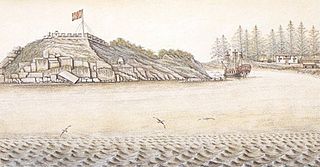
Fort San Miguel was a Spanish fortification at Yuquot on Nootka Island, just west of north-central Vancouver Island. It protected the Spanish settlement, called Santa Cruz de Nuca, the first colony in British Columbia.
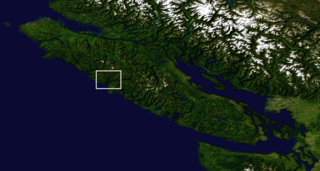
The Nootka Crisis, also known as the Spanish Armament, was an international incident and political dispute between the Nuu-chah-nulth Nation, Spain, the Kingdom of Great Britain, and the fledgling United States of America triggered by a series of events revolving around sovereignty claims and rights of navigation and trade. It took place during the summer of 1789 at the Spanish outpost Santa Cruz de Nuca, in Nootka Sound on Vancouver Island in present-day British Columbia, Canada. The commander of the outpost, Jose Esteban Martínez, seized some British commercial ships which had come for the maritime fur trade and to build a permanent post at Nootka Sound. Public outcry in Britain led to the mobilization of the Royal Navy, and the possibility of war. Both sides called upon allies, the Dutch joined the side of Britain; Spain mobilized their navy and her key ally France also mobilized theirs, but the latter soon announced they would not go to war. Without French help, Spain had little hope against the British and the Dutch, resulting in Spain seeking a diplomatic solution and making concessions.
John Rodgers Jewitt was an English armourer who entered the historical record with his memoirs about the 28 months he spent as an enslaved captive of Maquinna of the Nuu-chah-nulth (Nootka) people on what is now the British Columbia Coast. The Canadian Encyclopedia describes Jewitt as a shrewd observer and his Narrative as a "classic of captivity literature". The memoir, according to the Dictionary of Canadian Biography, is a major source of information about the indigenous peoples of the Pacific Northwest Coast.
Princess Royal was a British merchant ship that sailed on fur trading ventures in the late 1780s, and was captured at Nootka Sound by Esteban José Martínez of Spain during the Nootka Crisis of 1789. Called Princesa Real while under the Spanish Navy, the vessel was one of the important issues of negotiation during the first Nootka Convention and the difficulties in carrying out the agreements. The vessel also played an important role in both British and Spanish exploration of the Pacific Northwest and the Hawaiian Islands. In 1790, while under Spanish control, Princesa Real carried out the first detailed examination of the Strait of Juan de Fuca by non-indigenous peoples, finding, among other places, the San Juan Islands, Haro Strait, Esquimalt Harbour near present-day Victoria, British Columbia, and Admiralty Inlet.
James Hanna was the first European to sail to the Pacific northwest to trade in furs. This maritime fur trade was an important factor in the early history of the Pacific Northwest and the westward expansion of the United States and Canada.

Santa Cruz de Nuca was a Spanish colonial fort and settlement and the first European colony in what is now known as British Columbia. The settlement was founded on Vancouver Island in 1789 and abandoned in 1795, with its far northerly position making it the "high-water mark" of verified northerly Spanish settlement along the North American west coast. The colony was established with the Spanish aim of securing the entire west coast of the continent from Alaska southwards, for the Spanish crown.

James Charles Stuart Strange was a British officer of the East India Company, one of the first maritime fur traders, a banker, and a Member of Parliament.
Margaret was an American ship built at Boston and launched in the fall of 1791. It was built for use in the maritime fur trade and was owned by Thomas Handasyd Perkins, Russell Sturgis, James and Thomas Lamb, and James Magee. It was armed with eight cannon and six to eight swivel guns. On its maiden voyage it left Boston with a crew of 25.

